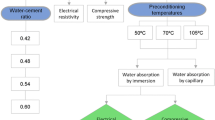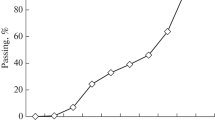Abstract
The main objective of this experimental study is to determine which of the effective parameter among ultrasonic pulse velocity, compressive strength, capillary water absorption and porosity during freezing and thawing on concrete produced with mineral admixtures. The specimens were exposed to 25, 50, 75 and 100 freezing-thawing cycles after 28 curing days. The results showed that among the measured parameters, capillary water absorption was the most affected parameter from freeze-thaw cycles.
Similar content being viewed by others
References
Aiqin, W., Chengzhia, Z., Mingshub, T., and Ningshengc, Z. (1999). “ASR in mortar bars containing silica glass in combination with high alkali and high fly ash contents.” Cement and Concrete Composites, Vol. 21, Nos. 5–6, pp. 375–382.
ASTM C 666-97 (2001). “Standard test method for resistance of concrete to rapid freezing and thawing.” Book of ASTM Standard, ASTM, West Conshohocken, DA.
ASTM C192-88 (1989). “Standard practice for making and curing test specimens in the laboratory.” Animal Book of ASTM Standard, Philadelphia, Vols. 04–02, pp. 112–118.
ASTM C143-89a (1994). Standard test method for slump of hydraulic cement concrete.
Berry, E. E., Hemmings, R. T., Zhang, M. H., Cornelius, B. J., and Golden, D.M. (1994). “Hydration in high-volume fly ash concrete binders.” ACI Mater. J., Vol. 91, No. 4, pp. 382–389.
Cabrera, J. G. and Lynsdale, C. J. (1988). “A new gas parameter for measuring the permeability of mortar and concrete.” Magazine of Concrete Research, Vol. l40, No. 7, pp. 177–182.
Dias, W. P. S. (2000). “Reduction of concrete sorptivity with age through carbonation.” Cement and Concrete Research, Vol. 30, No. 8, pp. 1255–1261.
Erdogan, Y. T. (2003). Beton, Metu Pres, Ankara, pp. 478–512.
Giaccia, G. M. and Malhotra, V. M. (1988). “Concrete incorporating high volumes of ASTM class F fly ash.” Cement Concrete and Aggregates, Vol. 10, No. 2, pp. 88–95.
Goldman, A. and Bentur, A. (1993). “The influence of micro filler on enhancement of concrete strength.” Cement and Concrete Research, Vol. 23, No. 4, pp. 962–972.
Gonen, T. and Yazicolu S. (2007). “The influence of mineral admixtures on the short and long-term performance of concrete.” Building and Environment, Vol. 42, No. 8, pp. 3080–3085.
Hooton, R. D. (1993). “Influence of silica fume replacement of cement on physical properties and resistance to sulfate attack, freezing and thawing, and alkali-silica reactivity.” ACI Materials Journal, Vol. 90, No. 2, pp. 143–151.
Langley, W. S., Carette, G. G., and Malhotra, V. M. (1992). “Strength development and temperature rise in large concrete blocks containing high volumes of low-calcium (ASTM class F) fly ash.” ACI Material Journal, Vol. 89, No. 4, pp. 362–368.
Loo, Y. H., Chin, M. S., Tam, C. T., and Ong, K. C. G. (1994). “A Carbonation prediction model for accelerated carbonation testing of concrete.” Magazine of Concrete Research, Vol. 46, No. 7, pp. 191–200.
Mehta, P. K. (1986). Concrete: Structure, properties, and materials, Prentice-Hall, Englewood, NJ.
Neville, A. M. (1995). Properties of concrete, 4th Ed., Longman Group, UK.
Papadakis, V. G., Fardis, M. N., and Veyenas, C. G., (1992). “Hydration and carbonation of pozzolonic cements.” ACI Materials Journal Technical Paper, Vol. 89, No. 2, pp. 119–130.
Rossignolo, J. A. and Agnesini, M. V. (2004). “Durability of polymermodified lightweight aggregate concrete.” Cement and Concrete Composites, Vol. 26, No. 4, pp. 375–380.
Sabir, B. B. (1997). “Mechanical properties and frost resistance of silica fume concrete.” Cement and Concrete Composites, Vol. 19, No. 4, pp. 285–294.
Sengul, O. and Tasdemir, M. A. (2009). “Compressive strength and rapid chloride permeability of concretes with ground fly ash and slag.” Journal of Materials in Civil Engineering, Vol. 21, No. 9, pp. 494–501.
Song, H.-W. (2007). “An estimation of the diffusivity of silica fume concrete.” Building and Environment, Vol. 42, No. 3, pp. 1358–1367.
Sun, W., Zhang, Y., Liu, S., and Zhang, Y. (2004). “The influence of mineral admixtures on resistance to corrosion of steel bars in green high-performance concrete.” Cement and Concrete Research, Vol. 34, No. 10, pp. 1781–1785.
Swamy, R. N., Ali, A. R., and Theodorakopoulos, D. D. (1983). “Early strength fly ash concrete for structural applications.” ACI Journal, Vol. 80, No. 5, pp. 414–423.
Tasdemir, C. (2003). “Combined effects of mineral admixtures and curing conditions on the sorptivity coefficient of concrete.” Cement and Concrete Research, Vol. 33, No. 10, pp. 1637–1642.
Toutanji, H., Delatte, N., Aggoun, S., Duval, R., and Danson, A. (2004). “Effect of supplementary cementitious materials on the compressive strength and durability of short-term cured concrete.” Cement and Concrete Research, Vol. 34, No. 2, pp. 311–319.
TS EN 206-1 (2002). Concrete-Part 1: Specification, performance, production and conformity, Turkish Standard Institution, Turkey.
TS EN 12390-3 (2002). Testing hardened concrete part 3: Compressive strength of test specimens, Turkish Standard Institution, Turkey.
Yazicioglu, S. and Demirel, B. (2006). “The effect of the pumice of Elazig Region used as a pozzolanic additive on the compressive strength of concrete in increasing cure ages.” Science and Engineering Journal of F rat University, Vol. 18, No. 3, pp. 367–374.
Author information
Authors and Affiliations
Corresponding author
Rights and permissions
About this article
Cite this article
Gonen, T., Yazicioglu, S. & Demirel, B. The influence of freezing-thawing cycles on the capillary water absorption and porosity of concrete with mineral admixture. KSCE J Civ Eng 19, 667–671 (2015). https://doi.org/10.1007/s12205-012-0207-7
Received:
Revised:
Accepted:
Published:
Issue Date:
DOI: https://doi.org/10.1007/s12205-012-0207-7




